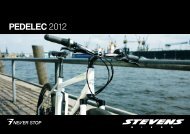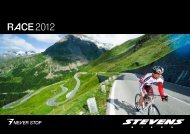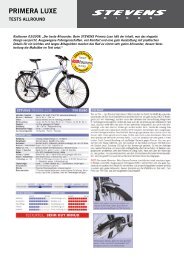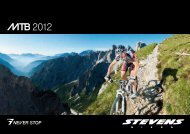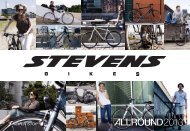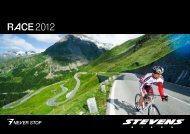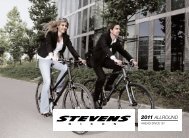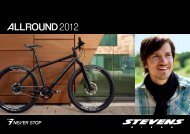2010 STEVENS — AheAd since '91
2010 STEVENS — AheAd since '91
2010 STEVENS — AheAd since '91
You also want an ePaper? Increase the reach of your titles
YUMPU automatically turns print PDFs into web optimized ePapers that Google loves.
suspension coMpeTence:<br />
ThomaS<br />
kAMM<br />
ThE gErMAN CoMPANy ANSWEr BIKE TEChNoLogy<br />
gMBh SPECIALIZES IN ThE dEVELoPMENT<br />
oF hydrAuLIC dAMPENINg SySTEMS. ThoMAS<br />
KAMM ANSWErEd A FEW quESTIoNS ABouT our<br />
FuLL SuSPENSIoN BICyCLES.<br />
Since 2006 you have been working closely with<br />
<strong>STEVENS</strong>. You designed the Fluent and Glide<br />
series, two very successful and renowned full<br />
suspension bikes. What were your goals during<br />
the development of the enduro Ridge 2011?<br />
don’t you always have to combine opposites in suspension<br />
development? on the one hand you want<br />
comfort and great suspension characteristics, on<br />
the other you try to create stiff and efficient frames.<br />
How do you achieve a good balance between<br />
the two?<br />
That’s exactly the challenge! using a 4-pivot “horst-<br />
Link” (or: classic 4-pivot) already lays the foundation<br />
to a lightweight but stiff chassis. But then, especially<br />
with large suspension travel, you have to adjust<br />
the kinematics with great care so that there are no<br />
disadvantages for the suspension characteristics.<br />
I’m quite proud of the successful combination of all<br />
these properties on the <strong>STEVENS</strong> ridge.<br />
Both <strong>STEVENS</strong> Glide and Ridge 2011 feature a<br />
modified concept for the rear section, the Fluent<br />
now has 120mm of suspension travel in the back<br />
and the front. Is there a trend towards increased<br />
22<br />
suspension travel? What did you change?<br />
definitely, bikes in all categories are getting more<br />
suspension travel. But this is due to the fact that the<br />
kinematics are getting better and better, while variable<br />
suspension travel eliminates all disadvantages.<br />
Additionally, for 2011 <strong>STEVENS</strong> bicycles come with<br />
superb balance of the front and rear suspension,<br />
and the glide and the ridge feature stiffer frames<br />
and X12 through-axles.<br />
What’s the secret of the “Anti-Squat Kinematics”<br />
of the <strong>STEVENS</strong> full suspension bikes?<br />
Anti-squat means the ability to transform the pedaling<br />
force into propulsion without loss of energy.<br />
Reviews in magazines point out the difference<br />
between pedal bob and pedal feedback. What’s<br />
more relevant?<br />
This is a very difficult question, as there’s no right or<br />
wrong answer. The <strong>STEVENS</strong> rear sections follow<br />
the “as much as necessary and as little as possible”<br />
principle. The advantages of the first need to<br />
eliminate the disadvantages of the latter. Specifically:<br />
if I don’t want to have pedal feedback (this is<br />
only possible in one specific gear and with specific<br />
adjustment), I automatically get pedal bob. If I don’t<br />
want any pedal bob (i.e. 100% anti-squat), I will have<br />
to put up with some pedal feedback. My completely<br />
personal opinion is this: Anti-squat (no energy<br />
loss uphill) has slightly higher priority, because it<br />
improves the kinematic response characteristics<br />
(better downhill characteristics) at the same time.<br />
Actually, in practice modern kinematics with these<br />
priorities show only very minimal pedal feedback.<br />
Can you give a few hints for a long and problemfree<br />
lifetime of a suspension bike?<br />
First of all you need sound bearings for the rear<br />
section, but you should also take care to avoid<br />
common mistakes: Steam cleaning should never be<br />
used to clean anything but the tires, if at all. Never<br />
steam clean bearings or drive train components!<br />
Apart from that, <strong>STEVENS</strong> rear sections are built<br />
with proven technology, and in case service really is<br />
necessary, parts can be repaired or replaced even<br />
after many years of use. Maintenance-free, doubly<br />
sealed rolling bearings as well as special bearings<br />
are used, each kind in the places where it’s the most<br />
appropriate.




